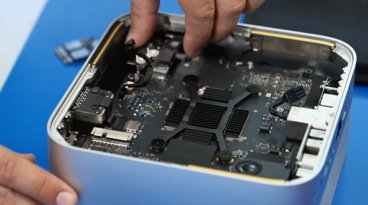Apple's main mobile processor manufacturer, TSMC, is reportedly set to begin commercial shipments of 10-nanometer chips in the next month — likely supporting claims that the "A11" processors in upcoming iPhones will use the technology.
Shipments of 10-nanometer chips should grow rapidly in the second half of the year, co-CEO Mark Liu confirmed at a company forum according to DigiTimes. Apple is typically expected to ship three new iPhones in the fall, including an "iPhone 8" as well as an "iPhone 7s" and "7s Plus."
Previous rumors suggested that TSMC had won orders to make a 10-nanometer "A11," and indeed other manufacturers such as Samsung are due to use the technology this year.
The processor in the iPhone 7 and 7 Plus, the A10 Fusion, is built using TSMC's 16-nanometer FinFET process. Shrinking die size can be money-saving for manufacturers, and beneficial to end users as well, since it often results in more efficient chips with less power consumption than would've otherwise been possible.
TSMC is meanwhile said to be planning "risk production" of 7-nanometer chips in the March quarter, switching into mass production in 2018 — possibly in time for that year's iPhones. 5-nanometer risk production is already slated for the first half of 2019.
While the "iPhone 7s" and "7s Plus" will likely be evolutionary upgrades, the "iPhone 8" is expected to feature a 5.8-inch, edge-to-edge OLED display, of which 0.7 inches will be dedicated to virtual buttons, replacing the physical home button Apple has had since 2007. The phone may also have 3D facial recognition and/or iris scanning.
 Roger Fingas
Roger Fingas








 Christine McKee
Christine McKee
 Charles Martin
Charles Martin

 Oliver Haslam
Oliver Haslam
 William Gallagher
William Gallagher

 Sponsored Content
Sponsored Content









23 Comments
Nothing new here. 7nm production would be interesting.
Wow, they are really moving fast. Desktop CPU have been shrink from 45nm (2008) to 32nm, to 28nm, to 22nm, to 14nm for a long time. It was just 2011/2012 that Apple uses the 45nm technology for the A5 chip. Now we are talking about 10nm this year and 7nm in 2018? I know this was the roadmap, but still, wow!
Wow - this is big - and sooner than expected. Intel has been struggling to achieve this milestone (in large quantities). Customers will benefit from longer battery life and faster procs! Hats off to the designers and engineers that make it possible.
It's interesting how processor manufacturers used went from focusing on the development of faster and faster processors, to now focusing on energy efficiency. Once they hit the 5nm mark, I can't imagine there will further improvements without some significant shift in overall processor design.
Help me understand this. An average strand of DNA is approx 7nm across. How can chips be built in this fashion? Also doesn't quantum tunneling come in to play here?